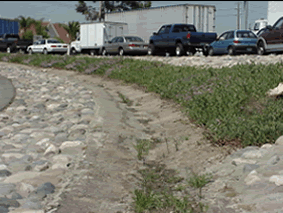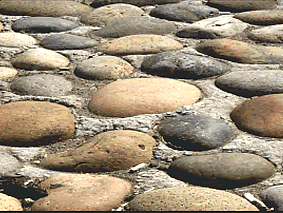Roadside Management Toolbox: Rock Blanket
What is This Treatment?
Rock blanket is a ground covering surface consisting of a layer of rock cobbles, either set in mortar or concrete and with or without a concrete base, for the purpose of aesthetics, or for functional purposes such as erosion control, storm water pollution prevention, or weed suppression
Where to Use This Design Concept?
Rock blanket may be placed within the State R/W as an aesthetic design element, an inert ground cover, a weed deterrent, a storm water pollution prevention control, an erosion control option, and also as an element to conserve resources by reducing maintenance effort and exposure to traffic by aiding in pesticide reduction.
Typical installation locations include but are not limited to the following:
- Embankment paving
- Median and/or drainage swales
- Slopes under bridges
- Slopes prone to erosion
- Drainage outlets
- Narrow areas
- Areas beyond the gore
- Between surface streets
- Loop areas within interchanges
- Problem planting areas
- Soft-bottom detention basin
- Roundabout designs
- Median islands
Design Considerations
The placement of rock blanket should achieve a balance between safety, maintainability, and aesthetics.
Safety
Rock blanket shall be placed to ensure the safety of maintenance workers and the public.
Selection of the placement site shall take into consideration the locations of all existing highway facilities including but not limited to plants, traffic and regulatory devices, and utility service facilities.
Rock blanket shall not be placed within the clear recovery zones, gore areas, areas beyond the gore, and any other locations which are subject to errant vehicles and pedestrian access, unless specific conditions exists and certain criteria are met (See Design Guidelines).
Maintainability
Rock and cobble shall not be place where the level of maintenance for that particular area would be increased as a result of the placement.
If properly placed, rock blanket will require minimal maintenance for weed control and removal of trash and debris. The deposition of silt and debris between the individual rocks or cobble over time contributes to weed growth. Consideration should be given to minimize the spaces between the individual rocks or cobble. This can be accomplished by setting the rocks/cobbles in concrete or mortar and/or varying the size of the rock. In areas which lend themselves to placement of rock without the use of mortar, a landscape fabric should be placed under the layer of rock.
Rock blanket shall be safely accessible by maintenance personnel.
Aesthetics
Rock blanket should compliment the adjacent surroundings, be an integral element of an area to be planted, and provide a visually pleasing form. The size and form of the area to receive the rock blanket shall compliment the adjacent plant material, the adjacent elements, and the geometric configuration of the roadway facility. The size of the rock must be considered with availability and color. Consideration must be also given to the slope of the area to accommodate aesthetics, constructability, safety, and maintainability.
Design Guidelines
Material Selection
Locally available cobble should be considered for rock blanket so the rock type, color, and sizes are appropriate to the local aesthetic and character and helps to keep material and delivery costs down.
Varying the sizes of the rock can contribute to a more natural appearance. Using this consideration may benefit areas which are not highly visible, where informal or natural vegetation occurs, and in areas where visibility is limited.
Consideration should be given to the desired sizes of the rock when mechanical installation can not be utilized. Without the availability of mechanical installation, there will be an increased amount of manual labor.
Site Location
Items to consider when choosing a site location:
- Will the site be large enough to accommodate the size and form of the rock blanket in addition to all of the other elements that will be adjacent to the rock blanket?
- Will the area be safe for maintenance personnel, particularly gore areas, areas beyond the gore, and narrow areas?
- What is the actual intent of the rock blanket: aesthetic or functional. Functional considerations include but are not limited to storm water pollution prevention, erosion control, and weed suppression?
- Can setback requirements be met for specific conditions?
- Will it provide a deterrent to pedestrian access and/or provide clear access for maintenance personnel for periodic maintenance?
- What is the angle of the slope? Consideration must be given to the expense and the constructability of the rock blanket on steep slopes. Where there is a potential for the rock blanket to slip and the blanket is to be installed in a bed of concrete or mortar, a concrete header shall be installed at the base of the blanket and a concrete band shall be install at the top of the blanket (See details).
- Will placement of rock blanket facilitate drainage? If so, the blanket should extend 2 to 3 feet beyond the toe of slope to prevent undermining.
Pedestrian Access
Every effort should be made to locate rock blanket away from pedestrian access. Issues include removal of rocks or cobbles and graffiti. When placement of rock blanket is near pedestrian access, physical barriers such as fences or plant masses should be placed between the rock blanket and pedestrians. Under conditions where rock blanket is accessible to pedestrians, the rock shall be set in concrete and mortared in place.
Placement in Clear Recovery Zones
When considering placement within clear recovery zones, consideration must be given to accidents reports and the history of errant vehicles driving through the barriers.
Placement may be made within clear recovery zone or near pedestrian access provided one or more of the following conditions exist:
- There is a physical barrier between the rock blanket and the roadway:
- Retaining walls
- Fences
- Guard rails
- Vertical curbs
- Concrete barriers
- There is a physical barrier between the rock blanket and pedestrians:
- Fences
- Plant masses
- Rock is mortared in place. In areas where rock blanket may be driven upon, rock is placed on a bed of concrete and mortared.
Construction Considerations
- Ensure there are sufficient funds in the contract for traffic control if ramps or lanes need to be closed due to the placement of the Rock blanket.
- Include rock availability information in the Resident Engineer File. Specify locally available rock whenever possible.
- Construction details need to reflect existing conditions.
- Examples of the preferred Rock and/or images of the finished product need to be available to the Contractor and the Resident Engineer.
- If the Rock blanket area is to be maintained during the life of the contract, include this area in the specifications in roadside clearing and in plant establishment to ensure continued maintenance when relief of maintenance is granted for roadway, pavement, and other items.
- Larger rock sizes greatly increase construction cost. Keep rock sizes in the cobble classification.
Specifications and Details
- Concrete Slope Paving Under Bridge
- Rock Blanket on Slope - Modify this Caltrans CAD file for Concrete Slope Paving Under Bridge
- Rock Blanket Detail - English Units (Microstation CAD File)
- Unmortared Rock Blanket Detail (Adobe Acrobat File)
Cost
- $85 - $120/yd2 at minimum thickness not including subbase or reinforcement.
- BEES Item(s) - 200114
Updated August 21, 2015



